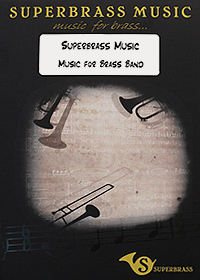4BR Roadtest: Virtuosi Baritone VB-521SP
14-Aug-2006Rob Richardson, Principal Baritone of the YBS Band casts his eye over the VB521 Virtuosi baritone from First Brass.
Introduction:
I remember reading a review on an entry-level Besson trombone by Jonathan Pippen a while back, which began by stating that it would be difficult to judge an instrument impartially which was specifically developed for novice/intermediate players and which fell within a price bracket which would be appropriate for this standard. 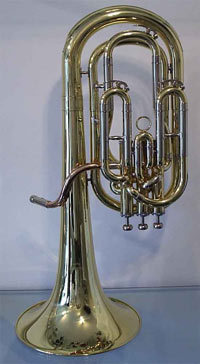 In all honestly, these were my initial thoughts too when first asked to look at the VB521 baritone, from First Brass' range of ‘Virtuosi' instruments.
In all honestly, these were my initial thoughts too when first asked to look at the VB521 baritone, from First Brass' range of ‘Virtuosi' instruments.
When first seeing the cost of the instrument, one might be deceived into thinking it was simply another cheap model designed to attract those not wanting to shell out a fortune on a pricy baritone, which may or not be used to its full potential.
It is available in lacquer or silver plated varieties, and is priced at £850 and £950 ince VAT respectively. But do not be put off by this seemingly low cost when compared to some more ‘established' makes of baritone, as its price in no way reflects the fine qualities of what is a very well designed, well put together instrument.
First Brass' policy is to produce affordable instruments that are available to everyone. They have certainly succeeded in sticking to this, and in addition have produced on instrument that is suitable for almost all standards and ages of player.
Please also note that many comments in this review take into consideration both the needs of the student player (one of the groups at which this instrument is aimed) and of the more experienced adult musician.
As usual we put the instrument through its paces and marked it out of 25 in four main sections to give an overall total out of 100. We played the SP version.
Those categories are: Build Quality and Design; Intonation; Ease of Blowing and Tonal quality and finally, Overall performance and value for money.
Build Quality and Design: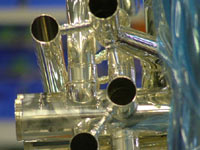
The team at First Brass has always stressed their commitment to building instruments of robust quality, and in this respect the VB521 does not disappoint. The problem areas which can be all too easily dented on especially the larger brass instruments are often the corners and bends on the tubing. The manufacturers have realised this, and every corner bend which could be an easy target for the ‘dent-gremlin' has been reinforced with extra casing around the knuckle. This has not been done so it causes any discomfort to the player, but as time progresses this would undoubtedly make a big difference, and would slow down the depreciation in value which often occurs with musical instruments.
One area which could be improved upon is the valve action, however this does not apply to everyone. The baritone's valves are very easy to depress when playing, but some (particularly adult) players could find this a slight hindrance, as many do prefer there to be that slight hint of resistance so the valves return to their original position as quickly as possible after being depressed. But for the younger player the light valve action would certainly aid progress in mastering faster, more technical passages.
Another slight gripe could possibly come from those with bigger hands is that the main piece of tubing running behind the valves could have done with being placed slightly further back, as the close proximity of tubing to valves does sometimes feel a tad too snug.
Overall: To sum up this section, even though there are several points to be made which could be improved upon, the Virtuosi baritone is generally a well thought out and sturdy instrument. 21 points
Intonation: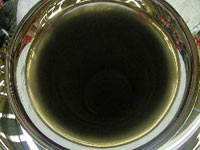
There are several notes on baritones which are notorious for being almost consistently out of tune on whichever instrument the player chooses to use. I have found that Fs (top line of the stave) and As (first ledger line up) have proven to be the main two notes associated with tuning problems on many baritones. When an instrument has inherent bad tuning on certain notes this can cause some distress to the player, as concerns such as ‘lipping up' and constant tuning slide manipulation can often get in the way of the real concert – making music.
On a personal level I remember once having to actually change instrument a short time before a contest due to several out of tune notes on my (former) instrument, clearly not the best preparation for a major event! Whether or not other brass players have had to resort to such drastic measures, I am sure many would be able to relate to a point in time where they experienced the same sort of problems.
Therefore it is a pleasure to say that this instrument is free of these problems. From the lowest pedal notes to the extreme upper register the Virtuosi baritone keeps nicely in tune, with even the aforementioned two problem notes being perfectly in tune. The instrument's excellent distinction of being one where one does not have to fret about tuning problems while playing is a great advantage for younger players who might choose to purchase this model, as they can, as touched upon before, concentrate entirely on the basics of playing without having unwanted hurdles to overcome.
Overall: The great intonation of the instrument is one of its biggest plus points, and is a feature which certainly enhances this particular baritone's marketability. 24 points
Ease of Blowing/Tonal Quality: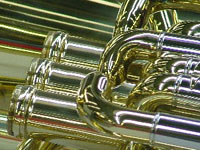
Again, this as an area which impresses greatly. Quality of sound is one of the most important facets of anyone's playing, and is always one of the main factors discussed when analysing somebody's prowess on whatever instrument they play. How many times have we heard brass band pundits come out with ‘…he/she's maybe not got as good a technique as some, but the sound that comes out of the bell is amazing!'
The Virtuosi baritone produces a dark, yet lightweight tone which is consistent throughout the range. The sound produced is one which does not take as much effort to make sound nice than on some other instruments which are currently available. It is appropriate for most levels of playing.
However, for serious solo work, especially when accompanied by a larger ensemble such as a brass band, the dark quality of tone which is a natural part of the instrument could prove in some situations to be a slight disadvantage to the player. Despite the warmly welcomed advances which are being made in baritone solo repertoire by some of the leading players in the country, it is part and parcel of playing the baritone that many solos played with band are originally written for euphonium.
This inevitably leads to the accompaniment parts sometimes being scored in a way which is too heavier for the lighter voice of the baritone, leading to the possibility of the solo voice being obscured. Despite the tone being sometimes a touch lightweight, this would in most situations not make a difference to the ability of the instrument to sound good in an ensemble.
Overall: Solo work would be the only situation in which some players might find it hard to sing through as much as is often required. 21 points
Overall Performance/Value for Money: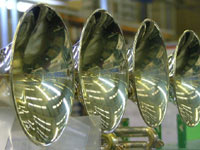
An instrument which plays as well as this one does can only be great value for money when given the price tag it has been. As said before, one of the main areas which the instrument (and in fact the entire range) is aimed at is young, student players. Many parents face bank-balance-busting problems when faced with the challenge of buying a new instrument for their child, but this instrument should go a long way towards alleviating at least some of the stress when working out finances for such purchases.
For most players (and especially learners and students) this instrument is a fantastic choice – easy and free to play, robustly built (something which will be greatly appreciated from those who know all too well the perils that accumulated knocks and bumps can bring to an instrument) and supplied with handy extras that one so often needs at a crucial moment.
This useful accessories kit includes a shoulder strap and a handy ‘care kit,' which includes cleaning brushes, valve grease and a cleaning cloth – items which are often needed but are too often absent from the player's case! Regarding the presentation of the package, one particular feature I was very impressed with was the quality and design of the case itself. On first glances the case is very much akin to that of the Prestige euphonium. Covered with black waterproof material and including a (very!!!) handy music pocket on the side, this case would be impressive in its own right whether included with an instrument or not.
Overall: Although a seemingly small factor, the music case is of immense assistance and is something which players of this instrument would undoubtedly welcome. 23 points
Final thoughts: 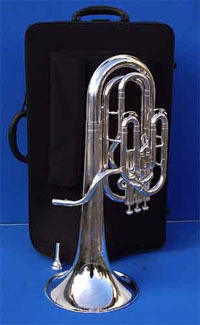 Overall this instrument is highly recommended for a wide range of players. It must be stressed that the points which have been made above are not in any way serious ones, but ones which certain players is certain playing situations might feel could be things to be improved on.
Overall this instrument is highly recommended for a wide range of players. It must be stressed that the points which have been made above are not in any way serious ones, but ones which certain players is certain playing situations might feel could be things to be improved on.
First Brass have built a quality instrument which would appeal to many baritone players even if the price tag were higher than it is – and the best thing is that it isn't!
A very welcome addition to the market, and one which is certain to be shown a lot of interest in the future.
Overall Total:
Build Quality and Design: 21 points
Intonation: 24 points
Ease of Blowing and Tonal quality: 21 points
Overall performance and value for money: 23 points
Overall Score: 89 points
Specification: 
Bore: 13.94mm
Bell diameter: 241mm
Stainless steel bottom sprung valaves
1st and 3rd slide and tuning slide waterkeys
Deatchable lyre box
Comes with extensive care kit
Price:
£850.00 for VB-521L
£950.00 for VB-521SP





